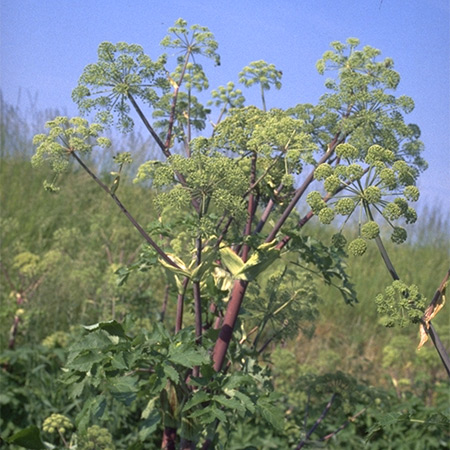Botanical name
Angelica archangelica L.
Family
Apiaceae
Common name
Angelica, Angelica Archangel, Garden angelica, Holy Ghost
Information about the plant
Angelica is native to all temperate zones of Europe and Asia, mainly growing in the northern zones. It prefers wet meadows, fens and riverbanks, and can also be found along sandy beaches.
The name "angel", which also appears in the Latin genus name Angelica (Latin 'angelicus' = angelic), refers to the legend that the medicinal plant was shown to people by an angel. The specific epithet archangelica (Lat. 'archangelicus' = archangel-) reinforces this idea. According to legend, it was the Archangel Raphael who brought to the attention of a hermit the healing properties of the plant.
The root has always been the healing part of the plant, which is why the name "Engelwurz" (translated from German as angel root) persists in German. Angelica is an herbaceous perennial that can reach a height of up to 2 meters. It grows out of a thick, turnip-shaped rootstock (rhizome), from which numerous thin (adventitious) roots, each up to 30 cm long, grow into the ground. When the underground parts are harvested and dried, they resemble "angelic" hair, possibly also explaining the origin of the name "Angelica". At the top of a thick, hollow, finely grooved, and branched stem, two to three pinnate leaves, up to 90 cm in size, sit with a conspicuously broad, bag-like inflated leaf sheath. The numerous, subtle greenish flowers form very large, hemispherical double umbels with 20 to 40 rays at the ends of the stem. The fruits are 5 to 8 mm long, pale yellowish, and disintegrate into two part-fruits each after dropping. Flowering time is from June to August.
Medicinally used parts of plants (herbal drug)
The dried underground parts are used, consisting of the (whole or cut) rhizome and roots (Angelica root - Angelicae radix). The commercial drug comes from crops in Thuringia, Poland and Holland.
Constituents of the herbal drug
Angelicae radix contains essential oil with mono- and sesquiterpenes; the typical musky scent of the oil is due to the macrocyclic lactones (including tri-, penta- and heptadecanolide). The drug also contains furanocoumarins and prenylated coumarins, as well as various phenolic carboxylic acids, fatty acids, and sucrose.
Quality of the drug
The quality of Angelicae radix is specified in the European Pharmacopoeia (Ph. Eur.).
Medical applications
Recognised medical use
Angelica root has not yet been evaluated by the HPMC.
ESCOP: dyspeptic complaints such as mild gastrointestinal spasms, sluggish digestion, flatulence and feeling of fullness, loss of appetite, and bronchitis; these applications are based on findings from long-term use in humans.
Traditional use
Traditionally used to support the digestive function or to support the gastrointestinal function and to stimulate the appetite (traditional use according to § 109a).
Herbal drug preparations in finished dosage forms
Cut Angelica root to prepare a tea, also in tea blends (stomach teas)
Fluid extracts in liquids
Alcoholic (50 %) extracts in drops
Alcoholic distillate in liquids
Dosage
Finished medicinal products: see patient information leaflet.
Tea infusion: a cup of Angelica root tea 2 to 3 times a day; to stimulate the appetite, the tea should be drunk half an hour before meals, and after meals in the event of indigestion. Daily dose 4.5 g of the drug.
A combination with other drugs such as centaury, wormwood and yarrow (stomach teas), or with caraway and fennel (gastrointestinal teas) is recommended.
Preparation of a tea
Pour approximately 150 mL of boiling water over 1.5 g of finely sliced or coarsely powdered Angelica root and strain after 10 to 15 min. Alternatively, preparation with cold water followed by brief boiling is also possible.
Notes
There is still no data available on the safety of Angelica root during pregnancy and lactation; the use in children and adolescents under the age of 18 is not recommended due to a lack of evidence.
Side effects
The furanocoumarins contained in Angelica root can increase skin photosensitivity, leading to phototoxic reactions when exposed to UV radiation.
Interactions
None known
References
Herbal drug monographs
ESCOP (2021)
Further literature
Commentary on the European Pharmacopoeia (Angelikawurzel, Nr. 1857)


